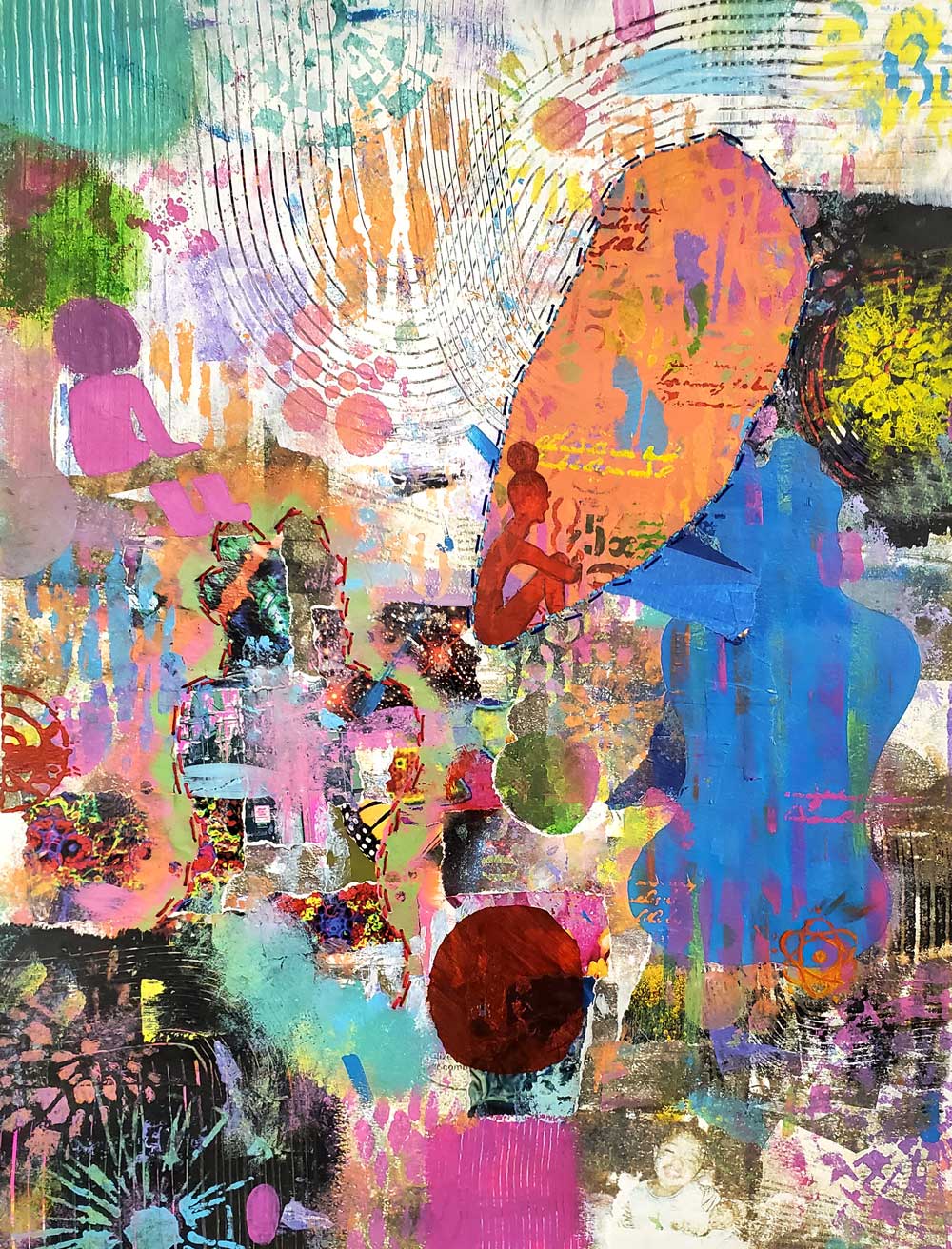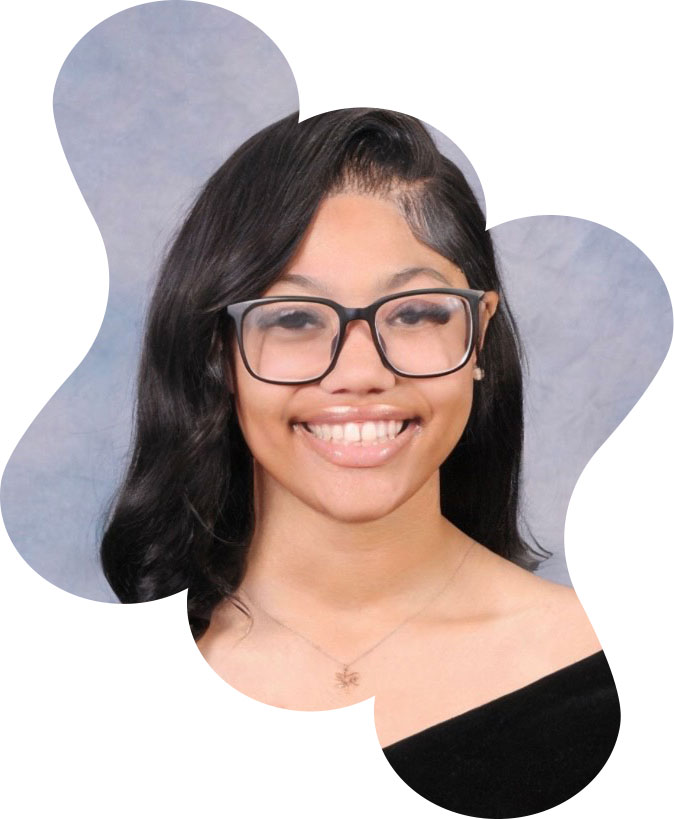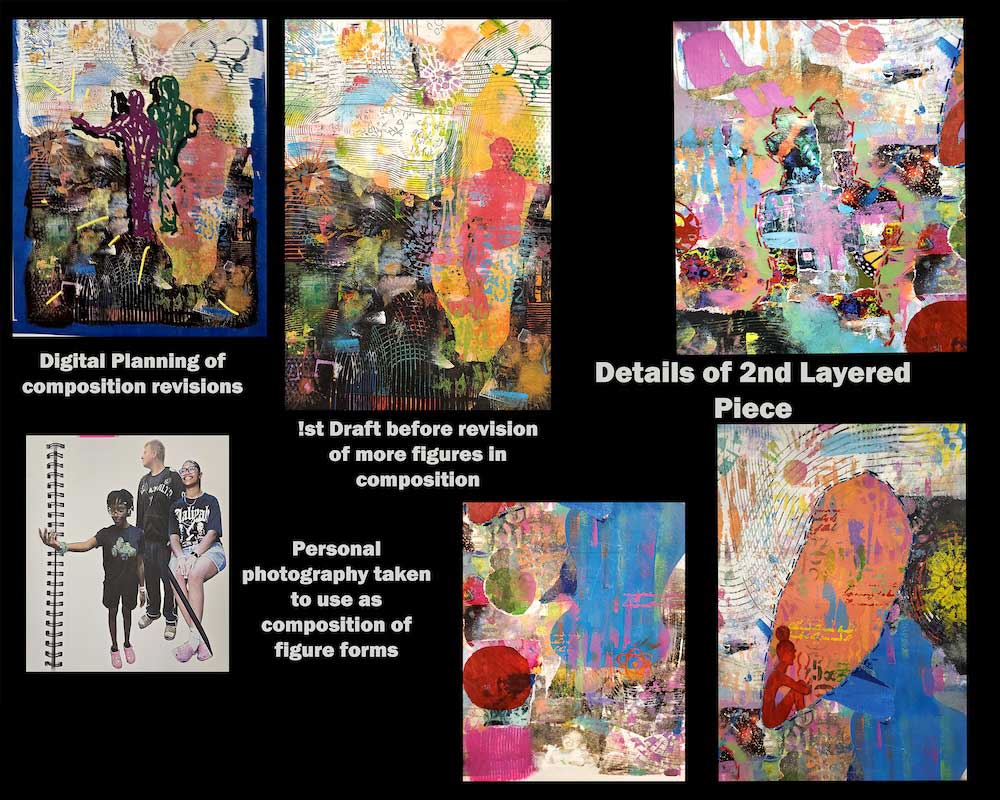

Underneath Me

Height: 16' x Width: 20" | Material(s): Acrylic paint, personal pictures, magazine pictures, strings, layered hand-cut stencils | Process(es): acetone trnsfered prsnl pics n usd mgazne pics n exprmntd w stncls to crate txtre n pt n usd strng | Citation(s): Personal pictures and magazine cutouts | Idea(s): I experimented using texture, composition, and depth to convey the emotions and experiences of my healing process. | Curatorial Note: Dynamic layering of colors, patterns, and mixed media that exemplifies the complicated and chaotic nature of healing oneself.
Meagan Kendrick


AP 2-D
Ida B. Wells APAC (Academic and Performing Arts Complex) and William B. Murrah High School
Jackson, MS, USA
Student statement
Student statement
Does your work reference or draw on a contemporary or historical art-making style, practice, or tradition? If so, please explain.
No reference to a specific style. I mostly based it around layering of different textures and materials.
What did you do to improve your 2-D, 3-D, or Drawing portfolio skills?
I dedicated time each day to practice and experiment with different 2-D techniques. As I received feedback from my art teachers, I tried to branch out into more layering and mixed media. I also looked back at recent artworks I've done and used those pieces to see where I needed growth.

Material(s): Acrylic paint, personal pictures, magazine pictures, strings, layered hand-cut stencils | Process(es): Used string to emphasize the important parts | Citation(s): Personal pictures and magazine cut outs under the painting from National Geographic | Idea(s): I experimented using texture, composition, and depth to convey the emotions and experiences of my healing process.
Describe the critique practices and feedback you received in AP Art and Design.
My teachers highlighted the more significant and more successful elements in my artwork. Since my art program is an arts magnet program, I have been able to work with my art teachers for multiple years, and they understood my strengths and weaknesses more in-depth than in a regular art class. Using their feedback, peer critiques, and self-reflection, I was able to focus on the areas where I could grow and develop my skills. We did this with one-on-one critiques, group critiques, and student progress logs for self-reflection.
In what ways did your artmaking confidence increase in AP Art and Design?
The way the AP Art and Design curriculum is set up, it gives me the opportunity to explore different art techniques and styles at my own speed and through personal choice. I was able to explore personal themes and allow myself to make artworks that reflected my own individual perspective. Being able to focus on experimentation was also very liberating and made me more confident in my art skills.
How can I show my healing process from past trauma and show it in my artwork?
How did you modify or revise your art-making direction based on feedback?
I always reflected on the feedback I received. Most of the feedback pushed me to do something or experiment with a material I haven't experienced before. I also tried to keep my creative touch with certain feedback I received and not lose my personal voice.
How did your classmates help you in the creative process?
They expressed how much they liked a certain area in the artwork and gave me feedback on the aesthetics and composition of pieces.
Did you participate in art shows at your school or in your community?
We submit our artworks in different local and national art contests, have our work displayed at numerous gallery spaces around my city, and have a big art show at the end of the year, where our AP portfolios are displayed together and our writing can be viewed. It was nice to receive feedback and praise from people in the community and my friends and family when our artwork was on display. They expressed how much they liked my pieces and were always ready to see what I could do next.
Do you show your work through social media? If so, did you use feedback from social media account(s) to help you make decisions about your artwork?
No social media, but I do get critiques and feedback from my teachers and classmates.
Renna Moore-Edwards
Visual Art Department Chair and AP Art teacher
Ida B. Wells APAC (Academic and Preforming Arts Complex) and William B. Murrah High School, Jackson, MS, USA
Teacher statement
Teacher statement
The AP Art and Design course supports inquiry-based personalized learning in the sustained investigation portfolio component. What strategies helped you guide students through inquiry?
In our program, most of our students are in our magnet-based art/academic class from 4th through12th grade. We teach techniques early so that we can start all art students, seventh grade and up, in a more independent-based curriculum where they focus on the process of planning, experimenting, and revising through critiques. As we move away from set projects, our students are very comfortable in creating their own compositions and exploring a theme because they have been independently creating at an earlier age. For teachers who do not have multiple levels of AP, I recommend partnering with a younger school or early level high school art classes where they can help teach the art of sketchbook planning, experimenting, and getting comfortable with adapting and revising their artwork.
How did you scaffold writing into the art-making and thinking processes?
I have students daily fill out studio progress logs where they note their brainstorming and research, experimentations, final planning, and revision choices. These progress logs are then used when they complete the writing for each piece. I have found that it helps my students remember why they made a specific decision and how that artistic choice relates back to their SI question.
How did you support skill development AND inquiry in the AP Art and Design curriculum?
We focus on skill development at an earlier age, but for the students that join our program at a later age, we have found that as they watch their classmates, they take tips from them and will also come to us and ask for specific technique skill building. We try to show them a lot of contemporary and different media-based art at the beginning of the year so that they can see all the options of materials and techniques they can use. We also will have life drawing and mark-making sessions, and a skill-building "boot camp" at the beginning of each semester.
Material(s): Acrylic paint, Posca marker | Process(es): pic of sis in bed traced on canvas , painted , left open to trace outlines , exper in sb w mater&com | Citation(s): Used my own reference picture that I took | Idea(s): I experimented using texture, composition, and depth to convey the emotions and experiences of my healing process.
How did you structure practice, experimentation, and revision into your AP Art and Design curriculum?
Practice, experimentation, and revision are how we score each student work in all our art classes and all grade levels. Each student receives a score on their idea/planning/sketchbook/etc., then a second grade on experimentation and technique skills, and the final grade for each piece is not scored until the student has shown revision and taken any peer/teacher feedback and revised the artwork. By doing this, they are super comfortable with the AP process when they join that class.
How do you support your students in the Selected Works portfolio component?
Our visual art department has a no copyright policy from 6th through12th grade. They focus on drawing from life and their own photography for references. Not having to worry about art of celebrities or pictures pulled off the internet helps bring up the quality and personal connection to their SW pieces. We also make sure that they are still bringing in synthesis in each piece. When they choice a technique, medium, or subject, I want to know why they made that choice and can it relate back to what the piece means.
What formative and summative assessments helped guide your students through your AP Art and Design curriculum?
We use weekly studio progress logs, and I keep a chart to track each student's one-on-one critiques and instruction. All summative assessments are rubric project-based scores.
What creative programming (i.e., exhibit spaces, mentoring programs, curricular supports) have you implemented to support AP Art and Design students?
We make sure our students have multiple opportunities to display their artwork and get feedback from other viewpoints. I also mentor AP Art and Design teachers throughout the state through my state's Art Edu association and Department of Education.
What did you learn from working with your student?
To have patience but be firm with deadlines. Also, let them explore on their own, but check in often to make sure they are still on track.
Meagan Kendrick
